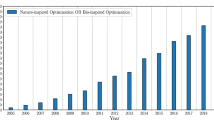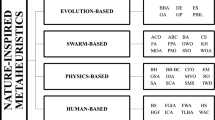Abstract
Although researchers often comment on the popularity of nature-inspired meta-heuristics (NIM), there has been very little empirical data to support the claim that NIM are growing in prominence compared to other optimization techniques. This paper presents strong evidence that the use of NIM is not only growing, but indeed appears to have surpassed mathematical optimization techniques and other meta-heuristics in several metrics related to academic research activity (publication frequency) and commercial activity (patenting frequency). Motivated by these findings, this article discusses some of the possible origins of this growing popularity including historical bias, conceptual appeal, simplicity of implementation, and algorithm utility.
Similar content being viewed by others
References
Hornby GS, Yu T (2008) A survey of practitioners of evolutionary computation. In: Studies in computational intelligence, vol 88, pp 283–297
Alander JT (1998) Indexed bibliography of genetic algorithms papers of 1996. Romania 3: 8
Cotta C, Merelo JJ (2007) Where is evolutionary computation going? A temporal analysis of the EC community. Genet Program Evolvable Mach 8(3): 239–253
Whitacre JM (2011) Survival of the Flexible: Explaining the Recent Popularity of Nature-Inspired Optimization within a Rapidly Evolving World. http://arxiv.org/ftp/arxiv/papers/0907/0907.0332.pdf. Computing. doi:10.1007/s00607-011-0156-x
Barabási AL, Albert R (1999) Emergence of scaling in random networks. Science 286(5439): 509–512
Dennett D (1995) Darwin’s dangerous idea. Simon & Schuster, New York
Blackmore S (2000) The meme machine. Oxford University Press, USA
Bonissone PP, Subbu R, Eklund N, Kiehl TR (2006) Evolutionary algorithms+ domain knowledge= real-world evolutionary computation. IEEE-TEC 10(3): 256
Contreras AR, Valero CV, Pinninghoff JMA (2005) Applying genetic algorithms for production scheduling and resource allocation: special case: a small size manufacturing company. In: Lecture notes in computer science, Springer, Berlin, pp 547–550
Bassett MH, Gardner LL, Steele K (2004) Dow AgroSciences uses simulation-based optimization to schedule the new-product development process. Interfaces 34(6): 426–437
Jiao LM, Khoo LP, Chen CH (2004) An intelligent concurrent design task planner for manufacturing systems. Int J Adv Manuf Technol 23(9): 672–681
Mak KL, Lau JSK, Wang XX (2005) A genetic scheduling methodology for virtual cellular manufacturing systems: an industrial application. Int J Prod Res 43(12): 2423–2450
Pérez-Vázquez ME, Gento-Municio AM, Lourenço HR (2007) Solving a concrete sleepers production scheduling by genetic algorithms. Eur J Oper Res 179(3): 605–620
Kolisch R, Hartmann S (2006) Experimental investigation of heuristics for resource-constrained project scheduling: an update. Eur J Oper Res 174(1): 23–37
Kotecha K, Sanghani G, Gambhava N (2004) Genetic algorithm for airline crew scheduling problem using cost-based uniform crossover. Lect Notes Comput Sci:84–91
Ahire S, Greenwood G, Gupta A, Terwilliger M (2000) Workforce-constrained preventive maintenance scheduling using evolution strategies. Decis Sci 31(4): 833–859
Cotta C, Fernandez AJ (2007) Memetic algorithms in planning, scheduling, and timetabling. Comput Intell (SCI) 49: 1–30
Author information
Authors and Affiliations
Corresponding author
Rights and permissions
About this article
Cite this article
Whitacre, J.M. Recent trends indicate rapid growth of nature-inspired optimization in academia and industry. Computing 93, 121–133 (2011). https://doi.org/10.1007/s00607-011-0154-z
Received:
Accepted:
Published:
Issue Date:
DOI: https://doi.org/10.1007/s00607-011-0154-z
Keywords
- Decision theory
- Evolutionary algorithms
- Mathematical programming
- Nature-inspired meta-heuristics
- Operations research
- Optimization




